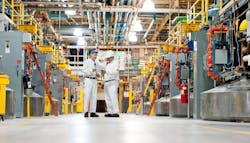Untangling Emissions: How The Chemical Industry Is Addressing Scope 3 Challenges
CP editors picked this story as one the top articles for 2023. To view all of our Editors' Choice picks for the year, visit https://chemicalprocessing.com/33016377.
To keep global warming from exceeding 1.5°C, as called for in the Paris Agreement, global emissions must drop 45% by 2030 and reach net zero by 2050.
For chemical manufacturers, one of the most contentious issues of the agreement is how to deal with Scope 3 emissions, those that the industry is indirectly responsible for across the value chain.
The challenges here are twofold: Deciding on the best ways to calculate greenhouse gas (GHG) emissions from upstream value chains and how to gather this data in the first place, says Mesbah Sabur, founder of Netherlands-based Circularise, which specializes in improving transparency and traceability across complex supply chains.
“Currently, there are slightly different frameworks and approaches to calculate Scope 3 emissions — ISO 14064, ISO 14067 for carbon footprint, GHG Protocol, etc. — and there are ongoing discussions on how to harmonize them,” he explains. “Furthermore, chemical companies need to gather data on the emissions factors and footprint of their upstream supply chain to determine their Scope 3 emissions. Today, much of this is done over email or through supplier questionnaires, which is very reactive and prone to error.”
The result is confusion, with companies implementing different strategies to address Scope 3 emissions, and activists saying many organizations are falling short of their commitments.
Ambiguity Abounds
Multinational oil and gas company BP is almost a case study in this regard. In February, the company said it plans to scale back oil and gas production by 25% by 2030. However, a year earlier, BP committed to cutting oil and gas production by 40% by 2030 as part of its strategy to reduce emissions and move to alternative energy sources. BP maintains that, if taken collectively, its climate targets are still Paris-agreement compliant.
It’s an argument that raises concerns with investors and environmental organizations.
For example, Brunel Pension Partnership in Bristol, U.K., is one of eight local government pension pools across the country and brings together £35 billion ($44 billion) of investments from 10 different funds.
On April 20, Brunel announced it would be voting against the reappointment of BP’s chair Helge Lund at the company’s April 27 annual general meeting (AGM).
Explaining the decision, Brunel’s chief responsible investment officer, Faith Ward says, “We acknowledge BP’s ambition to be net-zero by 2050 or before and the increased commitment to invest in solutions, but we are using our votes at the AGM to flag our concerns about the changes in strategy. There was no shareholder engagement regarding the reductions in commitments relating to oil and gas production — a material change to the plan presented to shareholders in 2022, and one that seriously imperils BP’s credibility as a company that will deliver on its promises.”
Another British pension fund to vote against Lund’s reappointment was Nest.
Explaining its decision, Diandra Soobiah, head of responsible investment, notes in a blog post that well-run organizations with sustainable environmental practices have a higher chance of long-term success and are more likely, over the long term, to provide good investment returns.
“But what happens when a company you invest in isn't on the same page or, even worse, sets targets to commit to be environmentally sustainable and doesn’t follow through on their promise?” she asks.
“By engaging with oil and gas companies, especially in collaboration with other investors, we have a better chance to help those that are progressing too slowly in their transition to a low-carbon economy,” Soobiah adds. “After all, as investors, we need to remember that the emissions of our investee companies are by default our emissions too.”
The two organizations were especially riled that BP’s altered production targets weren’t up for discussion at the April shareholder meeting, despite the earlier ones being approved at the 2022 AGM.
The Financial Times described this behavior as confusing at best and urged BP to “eschew slipperiness and try for clarity and transparency instead.”
At the same time, Dutch environmental group Follow This urged other shareholders to consider several factors before casting their votes on its resolution, which called for BP to align its 2030 Scope 3 emissions reduction aims with the goal of the Paris Agreement.
Follow This pointed out that BP says it “anticipates” its absolute Scope 3 emissions of marketed products to increase by 2030 with its current strategy. It also remains unclear whether BP’s absolute total Scope 3 emissions — marketed and traded — will increase by 2030.
Shell is experiencing similar issues.
“We believe our climate targets are aligned with the more ambitious goal of the UN Paris Agreement on climate change: to limit the increase in the average global temperature to 1.5°C above pre-industrial levels,” a spokesperson told Chemical Processing.
In 2021, the company set a new target to reduce absolute emissions from activities under its operational control 50% by 2030, compared with 2016 on a net basis. This covers Scope 1 and 2, where Shell is a user of energy.
Shell believes a dramatic change in demand for energy is just as critical as the required changes to supply for the energy transition to take place. Hence, it says, an essential part of its strategy is working with customers across different sectors, combined with advocating progressive government policies, to transform demand and assist customers in reducing their Scope 3 emissions.
“We have made good progress in reducing carbon emissions from our oil and gas operations, with a 30% reduction by the end of 2022, compared with 2016 on a net basis,” adds the spokesperson. “That puts us more than halfway toward our target to reduce them by 50% by 2030. We have also continued to change the energy mix of our portfolio. By the end of 2022, the net carbon intensity of the energy products we sell had fallen by 3.8%, compared with 2016.”
Shell’s approach as an energy provider is to set a target to reduce the net carbon intensity of the energy products it sells 20% by 2030, with a goal to become net zero by 2050, i.e., have zero absolute emissions by 2050.
“We believe that this target is in line with estimates based on the IPCC [Intergovernmental Panel on Climate Change] scenarios, which show that the net carbon intensity of the energy mix will need to fall by around 15% to 35% by 2030,” the spokesperson says. “We also believe this target takes into account the time needed for energy users to invest in large-scale equipment and the energy infrastructure changes needed for Shell to deliver more low- and zero-carbon energy.”
Still, a resolution at Shell’s May shareholder meeting urged the company to set more ambitious Scope 3 emissions reduction targets.
“Doing so, without changing demand and the way in which customers use energy, would effectively mean handing over retail and commercial customers to competitors,” claims the spokesperson. “This would materially affect Shell’s financial strength and limits its ability to generate value for shareholders. It would also reduce Shell’s ability to play an important role in the energy transition by working with its customers to reduce their emissions.”
Follow This has tabled similar resolutions at the AGMs of TotalEnergies, Exxon Mobil and Chevron.
Circularise's Sabur believes that by using traceability technologies to create digital product passports, chemical companies will be able to gather the information required for Scope 3 emissions much more effectively.
“These solutions also follow and keep up to date all the different standards, so companies won't need to worry about whether they are complying with the latest standards and frameworks,” he explains.
The other issue Sabur raises is the incentivization of a shift toward circular economy models.
“We believe that one of the biggest barriers to the shift to a more circular economy is the lack of information flow between supply-chain actors,” he says. “If chemical companies can track and trace how their products flow through the supply chain and end up in final products, and moreover how these final products reach their end-of-life and are disposed of, they can design and develop better polymers and compounds that can be more easily recovered and recycled. It can also allow chemical companies to examine new business models like take-back schemes or closed-loop approaches to minimize waste.”
Tackling the Value Chains
One company embracing this approach is Evonik Industries.
As part of its Next Generation Evonik strategy, the company, based in Essen Germany, says it is committed to being “well below the 2⁰C target” of the Science Based Targets Initiative (SBTi) – a joint enterprise involving CDP, United Nations Global Compact, and the World Resources Institute.
“Reducing Scope 3 emissions is challenging for the entire value chain because these emissions are outside their direct sphere of influence and are affected by many external factors,” says Evonik’s external communications manager Bernd Kaltwasser. “That necessitates intensive cooperation with partners along the value chain. We aim to reduce our Scope 3 emissions in all upstream categories and in the category ‘downstream transportation and distribution’ by 11% between 2021 and 2030.”
To begin with, the company is analyzing which raw materials and suppliers offer the greatest potential for reduction. The starting point here comprises secondary data from databases but also, increasingly, primary data.
“To increase the proportion of primary data, we contact our key suppliers once a year. In this context, we discuss, among other things, the main ways we can leverage emissions reduction with our suppliers. That may be renewable energies, improved processes or alternative raw materials. Taking the overview of all factors, we then discuss specific targets with our suppliers,” says Kaltwasser.
As an example of this reform in action, he cites the 2022 letter of intent signed on a strategic alliance with engineering contractor Pörner Group, Vienna, Austria, and Phichit Bio Power, Phichit, Thailand, to offer the global tire industry a bio-based silica made from rice husk ash. “This allows us to reduce the CO2 footprint by 30% compared to our standard silica. Thus, we support our customers’ focus on reducing carbon emissions and circularity,” explains Kaltwasser.
While the short-term availability of low-carbon raw materials remains limited, Evonik uses detailed mid- and long-term scenario analyses to align its procurement strategies.
For example, green hydrogen is expected to drive the energy transition in the area of raw materials. That opens opportunities for the production of green ammonia and green methanol. In the methanol process, CO2 removal is possible, so the product would have a negative carbon footprint.
“Evonik is monitoring these developments and is in close contact with potential suppliers. Since ammonia can be used as a transport medium for hydrogen and as a substitute for marine diesel, we assume that the development here will be faster than for other raw materials,” he adds.
One step toward reducing its Scope 3 emissions is using green C4 fraction produced from green naphtha in Marl, Germany. There are signs of a significant increase in volumes, notes Kaltwasser, especially biomethanol, which is used to produce MTBE (Methyl tert-butyl ether). In addition, green acetone is being used to make sustainable isophorone products.
“We have also extended certification under the mass balance standard of the Roundtable on Sustainable Palm Oil. For the first time, we are able to report process improvements on the supplier side as a Scope 3 measure thanks to the improved data transparency resulting from various supplier commitments,” he adds.
Meanwhile, Circularise has carried out projects with companies including Shell, Neste, Borealis and Trinseo, focused on how digital traceability can support the ISCC Plus certification scheme by using mass balance accounting for bio-based and recycled feedstock. This certification covers food, feed, bio-based products, energy and biofuel.
“Such certifications provide oil and gas and chemical companies with a way to transition away from the use of fossil fuels and increase their production of bio-based and recycled feedstock. Perhaps this can be the ‘happy medium’ that allows these companies to maintain some of their existing operations and more smoothly transition towards net zero,” suggests Mesbah.
About the Author
Seán Ottewell
Editor-at-Large
Seán Crevan Ottewell is Chemical Processing's Editor-at-Large. Seán earned his bachelor's of science degree in biochemistry at the University of Warwick and his master's in radiation biochemistry at the University of London. He served as Science Officer with the UK Department of Environment’s Chernobyl Monitoring Unit’s Food Science Radiation Unit, London. His editorial background includes assistant editor, news editor and then editor of The Chemical Engineer, the Institution of Chemical Engineers’ twice monthly technical journal. Prior to joining Chemical Processing in 2012 he was editor of European Chemical Engineer, European Process Engineer, International Power Engineer, and European Laboratory Scientist, with Setform Limited, London.
He is based in East Mayo, Republic of Ireland, where he and his wife Suzi (a maths, biology and chemistry teacher) host guests from all over the world at their holiday cottage in East Mayo.



